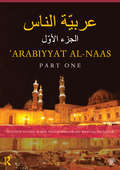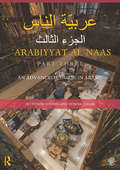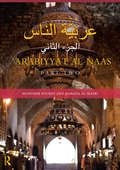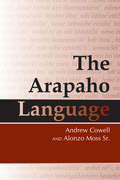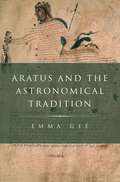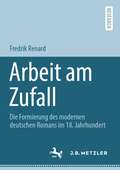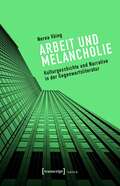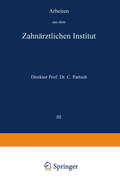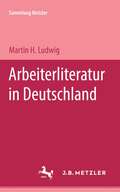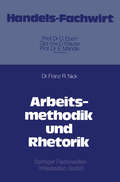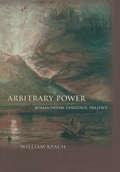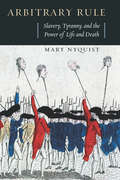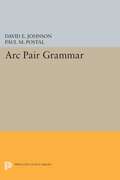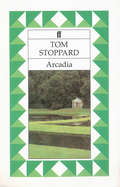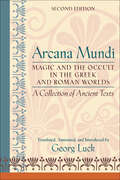- Table View
- List View
Arabiyyat al-Naas (Part One): An Introductory Course in Arabic
by Maha Saliba Foster Makda Weatherspoon Munther Younes‘Arabiyyat al-Naas (Part One) offers a groundbreaking introduction to Arabic as it is written and spoken by native speakers. It combines a progressive and rigorous grounding in Modern Standard Arabic (MSA) – the form employed for reading, writing and formal speaking – with an innovative integration of the spoken Levantine variety used in everyday situations in Syria, Lebanon, Jordan and Palestine. Introducing the two simultaneously ‘Arabiyyat al Naas (Part One) uses each in its proper context: Levantine for conversations and MSA for reading and writing activities. In this way, the course efficiently prepares students for the practical realities of learning and "living" Arabic today. Features include: 21 theme-based units covering all the core topics expected in a first-year Arabic course, such as countries, clothes, colors, family and professions a broad range of stimulating activities and exercises fostering active engagement with the course and the development of comprehension and communication skills comprehensively covers the 5 Cs: communication, culture, connections, comparisons and communities a free DVD filmed on location in Jordan, presenting over 40 videos and incorporating a wide variety of entertaining and realistic scenarios a free companion website (www.routledge.com/cw/younes) offering a wealth of additional instructor and student resources, including a teacher’s guide, an introduction to the letters and sounds of Arabic (with audiovisual aid and writing demonstrations), audio recordings of songs and listening passages, video clips, sample tests, an answer key and language games clear explanations of grammatical structures and concepts as they occur in the reading and listening materials to encourage progressive learning and active interaction with the text a user-friendly and vibrant full colour text design, richly illustrated throughout with over 200 illustrations and photographs songs with simple lyrics tied to the themes of the course to help advance vocabulary acquisition and understanding of basic grammatical structures. Written by a dynamic author team and tested over a number of years at Cornell University, ‘Arabiyyat al-Naas (Part One) will be an essential resource for students beginning to learn Arabic. While primarily designed for classroom use, the accessibility of the course and website also renders it highly suitable for independent study. This volume is the first in an exciting three-part series of Arabic textbooks which together provide a complete three-year undergraduate language program.
Arabiyyat al-Naas (Part One): An Introductory Course in Arabic
by Maha Saliba Foster Makda Weatherspoon Munther Younes‘Arabiyyat al-Naas (Part One) offers a groundbreaking introduction to Arabic as it is written and spoken by native speakers. It combines a progressive and rigorous grounding in Modern Standard Arabic (MSA) – the form employed for reading, writing and formal speaking – with an innovative integration of the spoken Levantine variety used in everyday situations in Syria, Lebanon, Jordan and Palestine. Introducing the two simultaneously ‘Arabiyyat al Naas (Part One) uses each in its proper context: Levantine for conversations and MSA for reading and writing activities. In this way, the course efficiently prepares students for the practical realities of learning and "living" Arabic today. Features include: 21 theme-based units covering all the core topics expected in a first-year Arabic course, such as countries, clothes, colors, family and professions a broad range of stimulating activities and exercises fostering active engagement with the course and the development of comprehension and communication skills comprehensively covers the 5 Cs: communication, culture, connections, comparisons and communities a free DVD filmed on location in Jordan, presenting over 40 videos and incorporating a wide variety of entertaining and realistic scenarios a free companion website (www.routledge.com/cw/younes) offering a wealth of additional instructor and student resources, including a teacher’s guide, an introduction to the letters and sounds of Arabic (with audiovisual aid and writing demonstrations), audio recordings of songs and listening passages, video clips, sample tests, an answer key and language games clear explanations of grammatical structures and concepts as they occur in the reading and listening materials to encourage progressive learning and active interaction with the text a user-friendly and vibrant full colour text design, richly illustrated throughout with over 200 illustrations and photographs songs with simple lyrics tied to the themes of the course to help advance vocabulary acquisition and understanding of basic grammatical structures. Written by a dynamic author team and tested over a number of years at Cornell University, ‘Arabiyyat al-Naas (Part One) will be an essential resource for students beginning to learn Arabic. While primarily designed for classroom use, the accessibility of the course and website also renders it highly suitable for independent study. This volume is the first in an exciting three-part series of Arabic textbooks which together provide a complete three-year undergraduate language program.
Arabiyyat al-Naas (Part Three): An Advanced Course in Arabic
by Munther Younes Yomna Chami‘Arabiyyat al-Naas (Part Three): An Advanced Course in Arabic builds further on the groundbreaking approach used in Part One and Part Two of the series. It integrates Modern Standard Arabic (MSA) and spoken Levantine in a way specially tailored to the needs of advanced students. Levantine Arabic strongly features in spoken discussions of MSA materials, reflecting authentic practice by native speakers. However, the overall ratio of MSA – the form employed for reading, writing and formal speaking in the Arab world – to Levantine has been increased, supporting students’ mounting need for MSA as they progress further in their education. This textbook is designed to take learners from the Advanced Low to the Advanced High level according to the ACTFL criteria, and from level B2 to C1 on the CEFR proficiency scales. Features include: 18 theme-based units covering topics such as Arab minorities; education; religion; love and marriage; the Arab woman; economics; politics; military matters; and the environment thorough coverage of listening, speaking, reading, and writing skills with clear grammar explanations and lessons structured to provide opportunities for further practice humorous, realistic dialogues reflecting educated speech among Arabs, to build up strong and practical communication skills attention to issues highly relevant to modern Arab society, encouraging active engagement with the course and further exploration of the themes a rich variety of reading passages from contemporary sources such as Al Jazeera as well as excerpts from the classic works One Thousand and One Nights and Kalila wa Dimna an extensive range of stimulating exercises and activities, including crossword puzzles, root-and-pattern identification exercises, passage completions, and free compositions free companion website (www.routledge.com/cw/younes) with the audio tracks, and texts of the listening passages and answer key. Developed by a dynamic author team and tested over a number of years at Cornell University, ‘Arabiyyat al-Naas (Part Three) is an essential resource for advanced-level students of Arabic. While primarily designed for classroom use, the accessibility of the course also renders it highly suitable for independent study. This volume is the final installment of a pioneering three-part series of Arabic textbooks which together provide a complete three-year undergraduate language program. Munther Younes and Yomna H. Chami both teach Arabic at Cornell University, USA.
Arabiyyat al-Naas (Part Three): An Advanced Course in Arabic
by Munther Younes Yomna Chami‘Arabiyyat al-Naas (Part Three): An Advanced Course in Arabic builds further on the groundbreaking approach used in Part One and Part Two of the series. It integrates Modern Standard Arabic (MSA) and spoken Levantine in a way specially tailored to the needs of advanced students. Levantine Arabic strongly features in spoken discussions of MSA materials, reflecting authentic practice by native speakers. However, the overall ratio of MSA – the form employed for reading, writing and formal speaking in the Arab world – to Levantine has been increased, supporting students’ mounting need for MSA as they progress further in their education. This textbook is designed to take learners from the Advanced Low to the Advanced High level according to the ACTFL criteria, and from level B2 to C1 on the CEFR proficiency scales. Features include: 18 theme-based units covering topics such as Arab minorities; education; religion; love and marriage; the Arab woman; economics; politics; military matters; and the environment thorough coverage of listening, speaking, reading, and writing skills with clear grammar explanations and lessons structured to provide opportunities for further practice humorous, realistic dialogues reflecting educated speech among Arabs, to build up strong and practical communication skills attention to issues highly relevant to modern Arab society, encouraging active engagement with the course and further exploration of the themes a rich variety of reading passages from contemporary sources such as Al Jazeera as well as excerpts from the classic works One Thousand and One Nights and Kalila wa Dimna an extensive range of stimulating exercises and activities, including crossword puzzles, root-and-pattern identification exercises, passage completions, and free compositions free companion website (www.routledge.com/cw/younes) with the audio tracks, and texts of the listening passages and answer key. Developed by a dynamic author team and tested over a number of years at Cornell University, ‘Arabiyyat al-Naas (Part Three) is an essential resource for advanced-level students of Arabic. While primarily designed for classroom use, the accessibility of the course also renders it highly suitable for independent study. This volume is the final installment of a pioneering three-part series of Arabic textbooks which together provide a complete three-year undergraduate language program. Munther Younes and Yomna H. Chami both teach Arabic at Cornell University, USA.
Arabiyyat al-Naas (Part Two): An Intermediate Course in Arabic (PDF)
by Munther Younes Hanada Al-MasriArabiyyat al Naas (Part Two): An Intermediate Course in Arabic offers a vibrant course in Arabic as it is written and spoken today by educated native speakers. Not only does it continue the innovative integration of Modern Standard Arabic (MSA) and Levantine Arabic used in Part One of the series, but it does so in a way that supports and develops students’ increased mastery of the language. Combining a greater focus on cultural topics with an increased coverage of MSA, Part Two introduces more sophisticated communication, giving students a deeper awareness of the cultural base of the Arabic language. Features include: Twenty-one theme-based units covering a wide range of relevant and engaging topics, including education and learning, jobs and professions, the Arab woman, religion, money and the economy, politics and government and the environment Thorough coverage of listening, speaking, writing and reading skills in every unit, with lessons structured to provide students with variety, stimulation and further opportunities for practice Humorous, realistic dialogues reflecting everyday educated speech among Arabs to build up strong and practical communication skills A rich variety of reading passages, including poems, short stories, newspaper articles, descriptions of Arab cities and biographies of famous figures, designed to improve comprehension and analytical skills and to deepen students’ knowledge of Arab history, culture, language, and literature An extensive range of appealing exercises and activities, including crossword puzzles, root-and-pattern identification exercises, passage completions, guided and free compositions, and songs Free accompanying CD that includes audio recordings of the listening materials in the 21 units and a number of songs tied to their themes Free companion website (www.routledge.com/cw/younes) featuring the texts of the listening passages, the audio recordings available on the CD , a track list of all the audio materials, the answer keys to the crossword puzzles, sample tests and language games. Developed by an experienced and dynamic author team and tested over a number of years at Cornell University, Arabiyyat al Naas (Part Two) will be an essential resource for intermediate-level students of Arabic. While primarily designed for classroom use, the accessibility of the course also renders it highly suitable for independent study. This volume is the second in a pioneering three-part series of Arabic textbooks which together provide a complete three-year undergraduate language program.
Arabiyyat al-Naas (Part Two): An Intermediate Course in Arabic
by Munther Younes Hanada Al-MasriArabiyyat al Naas (Part Two): An Intermediate Course in Arabic offers a vibrant course in Arabic as it is written and spoken today by educated native speakers. Not only does it continue the innovative integration of Modern Standard Arabic (MSA) and Levantine Arabic used in Part One of the series, but it does so in a way that supports and develops students’ increased mastery of the language. Combining a greater focus on cultural topics with an increased coverage of MSA, Part Two introduces more sophisticated communication, giving students a deeper awareness of the cultural base of the Arabic language. Features include: Twenty-one theme-based units covering a wide range of relevant and engaging topics, including education and learning, jobs and professions, the Arab woman, religion, money and the economy, politics and government and the environment Thorough coverage of listening, speaking, writing and reading skills in every unit, with lessons structured to provide students with variety, stimulation and further opportunities for practice Humorous, realistic dialogues reflecting everyday educated speech among Arabs to build up strong and practical communication skills A rich variety of reading passages, including poems, short stories, newspaper articles, descriptions of Arab cities and biographies of famous figures, designed to improve comprehension and analytical skills and to deepen students’ knowledge of Arab history, culture, language, and literature An extensive range of appealing exercises and activities, including crossword puzzles, root-and-pattern identification exercises, passage completions, guided and free compositions, and songs Free accompanying CD that includes audio recordings of the listening materials in the 21 units and a number of songs tied to their themes Free companion website (www.routledge.com/cw/younes) featuring the texts of the listening passages, the audio recordings available on the CD , a track list of all the audio materials, the answer keys to the crossword puzzles, sample tests and language games. Developed by an experienced and dynamic author team and tested over a number of years at Cornell University, Arabiyyat al Naas (Part Two) will be an essential resource for intermediate-level students of Arabic. While primarily designed for classroom use, the accessibility of the course also renders it highly suitable for independent study. This volume is the second in a pioneering three-part series of Arabic textbooks which together provide a complete three-year undergraduate language program.
The Aran Islands
by John M. SyngeHere is the complete title: Collected Plays and Poems and The Aran Islands
The Arapaho Language: Language And Power Among The Northern Arapaho
by Andrew Cowell Alonzo Moss, Sr.The Arapaho Language is the definitive reference grammar of an endangered Algonquian language. Arapaho differs strikingly from other Algonquian languages, making it particularly relevant to the study of historical linguistics and the evolution of grammar. Andrew Cowell and Alonzo Moss Sr. document Arapaho's interesting features, including a pitch-based accent system with no exact Algonquian parallels, radical innovations in the verb system, and complex contrasts between affirmative and non-affirmative statements. Cowell and Moss detail strategies used by speakers of this highly polysynthetic language to form complex words and illustrate how word formation interacts with information structure. They discuss word order and discourse-level features, treat the special features of formal discourse style and traditional narratives, and list gender-specific particles, which are widely used in conversation. Appendices include full sets of inflections for a variety of verbs. Arapaho is spoken primarily in Wyoming, with a few speakers in Oklahoma. The corpus used in The Arapaho Language spans more than a century of documentation, including multiple speakers from Wyoming and Oklahoma, with emphasis on recent recordings from Wyoming. The book cites approximately 2,000 language examples drawn largely from natural discourse - either recorded spoken language or texts written by native speakers. With The Arapaho Language, Cowell and Moss have produced a comprehensive document of a language that, in its departures from its nearest linguistic neighbors, sheds light on the evolution of grammar.
Arbeit am Zufall: Die Formierung des modernen deutschen Romans im 18. Jahrhundert
by Fredrik RenardDer Band untersucht das Modernwerden des deutschen Romans im 18. Jahrhundert als eine narrativierte Auseinandersetzung zwischen Zufall und Romanform. Die ‚Arbeit am Zufall‘ beschreibt, wie der moderne Roman sich selbst formt, indem er auf verschiedene Weise Zufälligkeit theoretisiert und narrativiert. Zufall ist in dieser Hinsicht sowohl das, was im Roman an Form gewinnen muss, aber auch das unerschöpfliche Potential, was wiederum den modernen Roman ständig erneuerbar macht.
Arbeit und Melancholie: Kulturgeschichte und Narrative in der Gegenwartsliteratur (Lettre)
by Nerea VöingErschöpfung, Depression, Burnout: Folgeprobleme von Erwerbsarbeit werden in literarischen Auseinandersetzungen zunehmend zum Sujet. Wilhelm Genazinos Angestellte, Karen Duves Taxifahrerin, Frédéric Beigbeders Werber, Terézia Moras Salesmanager - sie alle werden als erschöpfte bis verzweifelte Figuren gezeichnet und offenbaren darüber eine (implizite) Kritik an veränderten Anforderungen der Arbeitsgesellschaft. Auf der Basis kulturgeschichtlicher Überlegungen und anhand ausgewählter Texte der Gegenwartsliteratur zeichnet Nerea Vöings komparatistische Studie nach, wie ausgerechnet die seit der Antike zur ›Feindin‹ der Arbeit stilisierte Melancholie zum Vehikel dieser kritischen Darstellung werden konnte.
Arbeitsmethodik und Rhetorik
by Franz R. NickWir alle kennen den Mitarbeiter im Betrieb, der hinter einem übervollen Schreibtisch sitzt, den ganzen Tag über fleißig arbeitet und dennoch am Abend feststellt, daß er trotz aller Mühe keine besondere Leistung erbracht hat. Ein anderer Mitarbeiter hingegen bewältigt dieselben Aufgaben in angemesse ner Weise, sein Arbeitsplatz ist übersichtlich und aufgeräumt, er findet sogar noch die Zeit, sich mit seinen Kollegen zu besprechen und ihnen mit Ratschlägen zu helfen. Dieser Mitarbeiter versteht es, seine Arbeit methodisch zu ver richten, der andere offenbar nicht. Dabei muß er nicht einmal unintelligent sein: Würde er systematisch geschult, seine Arbeit im Hinblick auf das gesteckte Ziel planvoll und geordnet zu verrichten, könnte er durchaus seine Leistung ver bessern. Der vorliegende Beitrag soll dem Leser die Grundlagen methodischer Arbeit aufzeigen, gleich welche Aufgaben ihm im einzelnen gestellt sind. Er ist in fünf Teile gegliedert. In den ersten beiden Kapiteln werden die G r u n d l a g e n der individuellen und der sozialen Arbeitsmethodik behandelt, also des zweck mäßigsten höchstpersönlichen Arbeitsverhaltens und der Wege zur erfolgreichen Bewältigung der zwischenmenschlichen Beziehungen. Danach wird die spezielle M e t h o d i k der mündlichen (Rhetorik) und der schriftlichen Kommunikation (formelle und inhaltliche Nachrichtengestaltung) untersucht. Eine Übersicht der Möglichkeiten zur Erfolgskontrolle der Arbeitsmethodik schließt den Beitrag ab. 3 Arbeitsmethodik und Rhetorik A. Individuelle Arbeitsmethodik Arbeitsmethodik umfaßt die Gesamtheit der Planungen und Maßnahmen zur Erreichung eines zielgerichteten und zielerfüllenden Arbeitsverhaltens.
Arbitrary Power: Romanticism, Language, Politics
by William KeachThis book explores previously unexamined links between the arbitrary as articulated in linguistic theories on the one hand, and in political discourse about power on the other. In particular, Willam Keach shows how Enlightenment conceptions of the arbitrary were contested and extended in British Romantic writing. In doing so, he offers a new paradigm for understanding the recurrent problem of verbal representation in Romantic writing and the disputes over stylistic performance during this period. With clarity and force, Keach reads these phenomena in relation to a rapidly shifting literary marketplace and to the social pressures in Britain generated by the French Revolution, the Napoleonic Wars, and the class antagonisms that culminated in the Peterloo Massacre. The question of what it means to think of language or politics as arbitrary persists through postmodern thinking, and this book advances an unfinished dialogue between Romantic culture and the critical techniques we currently use to analyze it. Keach's intertwined linguistic and political account of arbitrary power culminates in a detailed textual analysis of the language of revolutionary violence. Including substantial sections on Blake, Wollstonecraft, Wordsworth, Coleridge, Byron, P. B. Shelley, Keats, and Anna Jameson, Arbitrary Power will engage not only students and scholars of eighteenth- and nineteenth-century literature but also those interested in critical and linguistic theory and in social and political history.
Arbitrary Power: Romanticism, Language, Politics (PDF)
by William KeachThis book explores previously unexamined links between the arbitrary as articulated in linguistic theories on the one hand, and in political discourse about power on the other. In particular, Willam Keach shows how Enlightenment conceptions of the arbitrary were contested and extended in British Romantic writing. In doing so, he offers a new paradigm for understanding the recurrent problem of verbal representation in Romantic writing and the disputes over stylistic performance during this period. With clarity and force, Keach reads these phenomena in relation to a rapidly shifting literary marketplace and to the social pressures in Britain generated by the French Revolution, the Napoleonic Wars, and the class antagonisms that culminated in the Peterloo Massacre. The question of what it means to think of language or politics as arbitrary persists through postmodern thinking, and this book advances an unfinished dialogue between Romantic culture and the critical techniques we currently use to analyze it. Keach's intertwined linguistic and political account of arbitrary power culminates in a detailed textual analysis of the language of revolutionary violence. Including substantial sections on Blake, Wollstonecraft, Wordsworth, Coleridge, Byron, P. B. Shelley, Keats, and Anna Jameson, Arbitrary Power will engage not only students and scholars of eighteenth- and nineteenth-century literature but also those interested in critical and linguistic theory and in social and political history.
Arbitrary Rule: Slavery, Tyranny, and the Power of Life and Death
by Mary NyquistSlavery appears as a figurative construct during the English revolution of the mid-seventeenth century, and again in the American and French revolutions, when radicals represent their treatment as a form of political slavery. What, if anything, does figurative, political slavery have to do with transatlantic slavery? In Arbitrary Rule, Mary Nyquist explores connections between political and chattel slavery by excavating the tradition of Western political thought that justifies actively opposing tyranny. She argues that as powerful rhetorical and conceptual constructs, Greco-Roman political liberty and slavery reemerge at the time of early modern Eurocolonial expansion; they help to create racialized “free” national identities and their “unfree” counterparts in non-European nations represented as inhabiting an earlier, privative age. Arbitrary Rule is the first book to tackle political slavery’s discursive complexity, engaging Eurocolonialism, political philosophy, and literary studies, areas of study too often kept apart. Nyquist proceeds through analyses not only of texts that are canonical in political thought—by Aristotle, Cicero, Hobbes, and Locke—but also of literary works by Euripides, Buchanan, Vondel, Montaigne, and Milton, together with a variety of colonialist and political writings, with special emphasis on tracts written during the English revolution. She illustrates how “antityranny discourse,” which originated in democratic Athens, was adopted by republican Rome, and revived in early modern Western Europe, provided members of a “free” community with a means of protesting a threatened reduction of privileges or of consolidating a collective, political identity. Its semantic complexity, however, also enabled it to legitimize racialized enslavement and imperial expansion. Throughout, Nyquist demonstrates how principles relating to political slavery and tyranny are bound up with a Roman jurisprudential doctrine that sanctions the power of life and death held by the slaveholder over slaves and, by extension, the state, its representatives, or its laws over its citizenry.
Arbitrary Rule: Slavery, Tyranny, and the Power of Life and Death
by Mary NyquistSlavery appears as a figurative construct during the English revolution of the mid-seventeenth century, and again in the American and French revolutions, when radicals represent their treatment as a form of political slavery. What, if anything, does figurative, political slavery have to do with transatlantic slavery? In Arbitrary Rule, Mary Nyquist explores connections between political and chattel slavery by excavating the tradition of Western political thought that justifies actively opposing tyranny. She argues that as powerful rhetorical and conceptual constructs, Greco-Roman political liberty and slavery reemerge at the time of early modern Eurocolonial expansion; they help to create racialized “free” national identities and their “unfree” counterparts in non-European nations represented as inhabiting an earlier, privative age. Arbitrary Rule is the first book to tackle political slavery’s discursive complexity, engaging Eurocolonialism, political philosophy, and literary studies, areas of study too often kept apart. Nyquist proceeds through analyses not only of texts that are canonical in political thought—by Aristotle, Cicero, Hobbes, and Locke—but also of literary works by Euripides, Buchanan, Vondel, Montaigne, and Milton, together with a variety of colonialist and political writings, with special emphasis on tracts written during the English revolution. She illustrates how “antityranny discourse,” which originated in democratic Athens, was adopted by republican Rome, and revived in early modern Western Europe, provided members of a “free” community with a means of protesting a threatened reduction of privileges or of consolidating a collective, political identity. Its semantic complexity, however, also enabled it to legitimize racialized enslavement and imperial expansion. Throughout, Nyquist demonstrates how principles relating to political slavery and tyranny are bound up with a Roman jurisprudential doctrine that sanctions the power of life and death held by the slaveholder over slaves and, by extension, the state, its representatives, or its laws over its citizenry.
Arbitrary Rule: Slavery, Tyranny, and the Power of Life and Death
by Mary NyquistSlavery appears as a figurative construct during the English revolution of the mid-seventeenth century, and again in the American and French revolutions, when radicals represent their treatment as a form of political slavery. What, if anything, does figurative, political slavery have to do with transatlantic slavery? In Arbitrary Rule, Mary Nyquist explores connections between political and chattel slavery by excavating the tradition of Western political thought that justifies actively opposing tyranny. She argues that as powerful rhetorical and conceptual constructs, Greco-Roman political liberty and slavery reemerge at the time of early modern Eurocolonial expansion; they help to create racialized “free” national identities and their “unfree” counterparts in non-European nations represented as inhabiting an earlier, privative age. Arbitrary Rule is the first book to tackle political slavery’s discursive complexity, engaging Eurocolonialism, political philosophy, and literary studies, areas of study too often kept apart. Nyquist proceeds through analyses not only of texts that are canonical in political thought—by Aristotle, Cicero, Hobbes, and Locke—but also of literary works by Euripides, Buchanan, Vondel, Montaigne, and Milton, together with a variety of colonialist and political writings, with special emphasis on tracts written during the English revolution. She illustrates how “antityranny discourse,” which originated in democratic Athens, was adopted by republican Rome, and revived in early modern Western Europe, provided members of a “free” community with a means of protesting a threatened reduction of privileges or of consolidating a collective, political identity. Its semantic complexity, however, also enabled it to legitimize racialized enslavement and imperial expansion. Throughout, Nyquist demonstrates how principles relating to political slavery and tyranny are bound up with a Roman jurisprudential doctrine that sanctions the power of life and death held by the slaveholder over slaves and, by extension, the state, its representatives, or its laws over its citizenry.
Arbitrary Rule: Slavery, Tyranny, and the Power of Life and Death
by Mary NyquistSlavery appears as a figurative construct during the English revolution of the mid-seventeenth century, and again in the American and French revolutions, when radicals represent their treatment as a form of political slavery. What, if anything, does figurative, political slavery have to do with transatlantic slavery? In Arbitrary Rule, Mary Nyquist explores connections between political and chattel slavery by excavating the tradition of Western political thought that justifies actively opposing tyranny. She argues that as powerful rhetorical and conceptual constructs, Greco-Roman political liberty and slavery reemerge at the time of early modern Eurocolonial expansion; they help to create racialized “free” national identities and their “unfree” counterparts in non-European nations represented as inhabiting an earlier, privative age. Arbitrary Rule is the first book to tackle political slavery’s discursive complexity, engaging Eurocolonialism, political philosophy, and literary studies, areas of study too often kept apart. Nyquist proceeds through analyses not only of texts that are canonical in political thought—by Aristotle, Cicero, Hobbes, and Locke—but also of literary works by Euripides, Buchanan, Vondel, Montaigne, and Milton, together with a variety of colonialist and political writings, with special emphasis on tracts written during the English revolution. She illustrates how “antityranny discourse,” which originated in democratic Athens, was adopted by republican Rome, and revived in early modern Western Europe, provided members of a “free” community with a means of protesting a threatened reduction of privileges or of consolidating a collective, political identity. Its semantic complexity, however, also enabled it to legitimize racialized enslavement and imperial expansion. Throughout, Nyquist demonstrates how principles relating to political slavery and tyranny are bound up with a Roman jurisprudential doctrine that sanctions the power of life and death held by the slaveholder over slaves and, by extension, the state, its representatives, or its laws over its citizenry.
Arbitrary Rule: Slavery, Tyranny, and the Power of Life and Death
by Mary NyquistSlavery appears as a figurative construct during the English revolution of the mid-seventeenth century, and again in the American and French revolutions, when radicals represent their treatment as a form of political slavery. What, if anything, does figurative, political slavery have to do with transatlantic slavery? In Arbitrary Rule, Mary Nyquist explores connections between political and chattel slavery by excavating the tradition of Western political thought that justifies actively opposing tyranny. She argues that as powerful rhetorical and conceptual constructs, Greco-Roman political liberty and slavery reemerge at the time of early modern Eurocolonial expansion; they help to create racialized “free” national identities and their “unfree” counterparts in non-European nations represented as inhabiting an earlier, privative age. Arbitrary Rule is the first book to tackle political slavery’s discursive complexity, engaging Eurocolonialism, political philosophy, and literary studies, areas of study too often kept apart. Nyquist proceeds through analyses not only of texts that are canonical in political thought—by Aristotle, Cicero, Hobbes, and Locke—but also of literary works by Euripides, Buchanan, Vondel, Montaigne, and Milton, together with a variety of colonialist and political writings, with special emphasis on tracts written during the English revolution. She illustrates how “antityranny discourse,” which originated in democratic Athens, was adopted by republican Rome, and revived in early modern Western Europe, provided members of a “free” community with a means of protesting a threatened reduction of privileges or of consolidating a collective, political identity. Its semantic complexity, however, also enabled it to legitimize racialized enslavement and imperial expansion. Throughout, Nyquist demonstrates how principles relating to political slavery and tyranny are bound up with a Roman jurisprudential doctrine that sanctions the power of life and death held by the slaveholder over slaves and, by extension, the state, its representatives, or its laws over its citizenry.
Arbitrary Rule: Slavery, Tyranny, and the Power of Life and Death
by Mary NyquistSlavery appears as a figurative construct during the English revolution of the mid-seventeenth century, and again in the American and French revolutions, when radicals represent their treatment as a form of political slavery. What, if anything, does figurative, political slavery have to do with transatlantic slavery? In Arbitrary Rule, Mary Nyquist explores connections between political and chattel slavery by excavating the tradition of Western political thought that justifies actively opposing tyranny. She argues that as powerful rhetorical and conceptual constructs, Greco-Roman political liberty and slavery reemerge at the time of early modern Eurocolonial expansion; they help to create racialized “free” national identities and their “unfree” counterparts in non-European nations represented as inhabiting an earlier, privative age. Arbitrary Rule is the first book to tackle political slavery’s discursive complexity, engaging Eurocolonialism, political philosophy, and literary studies, areas of study too often kept apart. Nyquist proceeds through analyses not only of texts that are canonical in political thought—by Aristotle, Cicero, Hobbes, and Locke—but also of literary works by Euripides, Buchanan, Vondel, Montaigne, and Milton, together with a variety of colonialist and political writings, with special emphasis on tracts written during the English revolution. She illustrates how “antityranny discourse,” which originated in democratic Athens, was adopted by republican Rome, and revived in early modern Western Europe, provided members of a “free” community with a means of protesting a threatened reduction of privileges or of consolidating a collective, political identity. Its semantic complexity, however, also enabled it to legitimize racialized enslavement and imperial expansion. Throughout, Nyquist demonstrates how principles relating to political slavery and tyranny are bound up with a Roman jurisprudential doctrine that sanctions the power of life and death held by the slaveholder over slaves and, by extension, the state, its representatives, or its laws over its citizenry.
Arc Pair Grammar (PDF)
by David E. Johnson Paul M. PostalArc pair grammar is a new, extensively formalized, theory of the grammatical structure of natural languages. As an outgrowth of relational grammar, it constitutes a theoretical alternative to the long-dominant generative transformational approach to linguistics. In this work, David Johnson and Paul Postal offer the first comprehensive presentation of this theoretical framework, which provides entirely new notions of all the basic concepts of grammatical theory: sentence, language, rule, and grammar.Originally published in 1981.The Princeton Legacy Library uses the latest print-on-demand technology to again make available previously out-of-print books from the distinguished backlist of Princeton University Press. These editions preserve the original texts of these important books while presenting them in durable paperback and hardcover editions. The goal of the Princeton Legacy Library is to vastly increase access to the rich scholarly heritage found in the thousands of books published by Princeton University Press since its founding in 1905.
Arcadia: Arcadia - The Real Thing - Night And Day - Indian Ink - Hapgood (Sparknotes Literature Guide Ser.)
by Tom StoppardIn a large country house in Derbyshire in April 1809 sits Lady Thomasina Coverly, aged thirteen, and her tutor, Septimus Hodge. Through the window may be seen some of the '500 acres inclusive of lake' where Capability Brown's idealized landscape is about to give way to the 'picturesque' Gothic style: 'everything but vampires', as the garden historian Hannah Jarvis remarks to Bernard Nightingale when they stand in the same room 180 years later.Bernard has arrived to uncover the scandal which is said to have taken place when Lord Byron stayed at Sidley Park.Tom Stoppard's absorbing play takes us back and forth between the centuries and explores the nature of truth and time, the difference between the Classical and the Romantic temperament, and the disruptive influence of sex on our orbits in life - 'the attraction', as Hannah says, 'which Newton left out'.
Arcana Mundi: Magic and the Occult in the Greek and Roman Worlds: A Collection of Ancient Texts (Textes Litteraires Du Moyen Age Ser. #21)
by Georg LuckMagic, miracles, daemonology, divination, astrology, and alchemy were the arcana mundi, the "secrets of the universe," of the ancient Greeks and Romans. In this path-breaking collection of Greek and Roman writings on magic and the occult, Georg Luck provides a comprehensive sourcebook and introduction to magic as it was practiced by witches and sorcerers, magi and astrologers, in the Greek and Roman worlds. In this new edition, Luck has gathered and translated 130 ancient texts dating from the eighth century BCE through the fourth century CE. Thoroughly revised, this volume offers several new elements: a comprehensive general introduction, an epilogue discussing the persistence of ancient magic into the early Christian and Byzantine eras, and an appendix on the use of mind-altering substances in occult practices. Also added is an extensive glossary of Greek and Latin magical terms. In Arcana Mundi Georg Luck presents a fascinating—and at times startling—alternative vision of the ancient world. "For a long time it was fashionable to ignore the darker and, to us, perhaps, uncomfortable aspects of everyday life in Greece and Rome," Luck has written. "But we can no longer idealize the Greeks with their 'artistic genius' and the Romans with their 'sober realism.' Magic and witchcraft, the fear of daemons and ghosts, the wish to manipulate invisible powers—all of this was very much a part of their lives."
